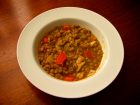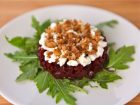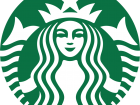We started talking about it over a year ago. At first, it was just talk. You know — big ideas but always with obstacles. People's schedules, availability of key items, location considerations. The whole gamut. But Al and I were committed to make it happen. After several broken dates and lapses of contact we agreed in late October to turn our dream into reality.
The dream? Quite simple. Get as many vintages of the “sine qua non” of California Cult Cabernet wines and drink them with good friends. The wine? Screaming Eagle. Its status? Legendary. Jean Phillips convinced her friend Heidi Barret to help here make cabernet sauvignon from a small vineyard plot in Oakville in California's Napa Valley. As they say, the rest is history.

The wine caught the attention of wine critic and seeming wine alchemist Robert Parker — that is, anything he scores 95 points or larger disappears from wine shop shelves in days — sometimes minutes. Funny thing is, many of these wines likely sit on the wine shop shelves for weeks or months with little or no sales activity. Then bam. Parker's newsletter, The Wine Advocate, hits subscriber mailboxes. Subscribers subsequently scan the ratings and buy anything he gives a huge score. Not quite the way to buy wine. Yet singlehandly this man has altered winemaking worldwide.
Sure. You think I'm kidding. But imagine if you sold a product at $35 and only had the ability to make 12,000 units annually. For years you struggle selling those 12,000 units. Then one day you wake up and find that overnight you were sold out. Why? Parker gave you 97 points. So next year you raise your price to $40. It still sells out and Parker still rates it in the stratosphere. Over the course of six years the price jumps to $150. You know have to allocate the number of units a single person can buy. And your demand is so strong you have to pass on selling it to retailers. Hell, going to direct you increase margin dramatically.
Robert Parker has affected dozens of wineries worldwide. So those who he hasn't graced with huge scores scramble to make a wine that he will like. In other words, they alter their winemaking technique for the sole purpose of getting a better score. True artisan winemakers will deny they would steep to such a low position. Others will gladly admit they are making a “parkerized” wine.

Is it fair that one man has so much influence over an industry? Perhaps. But to his credit it's important to note that Parker's Wine Advocate accepts no advertising. Yet, the People Magazine of the wine industry, The Wine Specator gladly accepts winery advertising. And an interesting analysis of those brands appearing on its Top 100 wines of the year with respect to advertising revenue generated from ads placed by the holding companies of those brands might raise questions. To be sure, The Wine Spectator's influence on the industry is a minute fraction of the aforementioned Parker. But its Wine of the Year always causes a rukus and results in inflated prices of that wine in the following year.
Case in point is the Chateau St. Jean Cabernet Sauvignon from Sonomo County. A few years ago the 1996 vintage claimed the top prize as Wine of the Year. At the time the wine retailed for less than $25. The following year the price balooned to $75. And it rested there for a few years. Though thankfully for consumers and perhaps to the chagrin of Foster's beer parent Wolf Blass who bought Chateau St. Jean as part of Beringer Holdings, the wine has crept down in price and is currently selling for $50 or less — still a huge jump from its pre-wine of the year days. In fact, I have a bottle of the 1994 Cinq Cepages with a price tag still proudly exhibiting $13.99. Even California real estate in Orange County hasn't increased as much.
What's this all have to do with a yearlong dream and several failed attempts to realize such a dream? Screaming Eagle. The first vintage Jean and Heidi collaborated on was 1992. Every vintage Robert Parker has rated this wine 96 points or more. In most cases the wine attains scores of 98-100. And according to Parker, his 100 point wines are perfect.
So if you'd like to try what Robert Parker calls a “perfect” wine, you'd want to get your hands on a bottle of Jean and Heidi's Screaming Eagle or any of the handful of other wines he scores with such veracity. Problem is, until recently Jean only bottled about 300 cases of Screaming Eagle. And unless you had the chance to discover this wine about the same time Sir Robert Parker did and went throught the motions to get your name on Jean's mailing list (the list is closed and there are several thousand people on the waiting list — which is also closed) you would be hard pressed to find a bottle of this wine.
So what happens. Greedy mailing list recipients and osbstinate collectors in search of the Rosetta Stone of wine have created a market where this wine fetches more than $2,000 a bottle at auction and sometimes $5,000 on wine lists in some of the finest restaurants in New York, Chicago or Las Vegas. Though recently the market broke on Screaming Eagle. So if you've got a hankering to try a bottle you might find one for $1,000 — but no less.
I wrote to Jean in 1997 hoping to get my hands on Screaming Eagle. And I patiently waited until sometime in 2002 I received a letter offering me a few bottles of the 1998 vintage. Since then I've bought my “allocation” each year. Jean and Heidi were disappointed in their crop and overall the 2000 vintage in California that they decided not to bottle a 2000 Screaming Eagle.

Most people simply get their allocation and sell it. The 2001 vintage retailed to mailing list recipients for $250 per bottle. Hammer prices at wine auctions find this wine selling anywhere from $1300-$1900 per bottle. But rather than sell this wine, several friends and I set out to taste multiple vintages. The occasion? Why not. Sure, my birthday sounded like a good excuse. The holidays another. And the old adage “life is long” so enjoy it seemed well enough another.
 The price of admission to this dinner held at one of Orange County's premier restaurants, Pinot Provence, was a bottle of Screaming Eagle. We did have a problem, however. My brother Jon who booked a flight from Washington DC to Orange County to taste these cult classics did not have a unique vintage. That is, we had duplicity. So we worked hard to find another vintage with the lofty goal of trading one of our duplicate vintages. But no luck. In the end, Jon and I agreed that we'd submit a worhty surrogate — the 1995 Bryant Family Vineyard — another cult classic that turned totally unattainable and priced out of sight by the simple words and scoring of Sir Robert Parker.
The price of admission to this dinner held at one of Orange County's premier restaurants, Pinot Provence, was a bottle of Screaming Eagle. We did have a problem, however. My brother Jon who booked a flight from Washington DC to Orange County to taste these cult classics did not have a unique vintage. That is, we had duplicity. So we worked hard to find another vintage with the lofty goal of trading one of our duplicate vintages. But no luck. In the end, Jon and I agreed that we'd submit a worhty surrogate — the 1995 Bryant Family Vineyard — another cult classic that turned totally unattainable and priced out of sight by the simple words and scoring of Sir Robert Parker.
Sitting on the table was more than $6,000 of wine — if you want to consider the current selling price (not restuarant price) of these wines. A bit decadnet? Yes. But to be fair, all of these wines came from personal cellars of my dinner guests and each of the guests hadn't opted to greedily sell their screaming eagles. All of us like minded souls interested in experiencing whatever magic Sir Robert Parker found in this small production Napa Valley wine.
But before we started into the big bad reds it was appropriate to start the eving with champagne and chardonnay. And to live up to the magnus level of red wines, we found it important to sample the recently released 1996 Dom Perignon Champagne(95 points) and perhaps the most sought after California chardaonnay the 2000 Marcassin Vineyard Chardonnay from Sonoma County (94 points) which as luscious, rich and viscous without the hindrance of oak or butter that plagues many over the top California Chardonnay. Nice hints of honey, butterscotch matched with bright acidity and notes of straw, honeysuckle and beauty.
The 1996 Screaming Eagle showed a bit of prune and raisin on the nose with mocha, sandlewood and earth on the palate finishing nicely with dried fruit and cherry, (92 points).
The 1998 Screaming Eagle went through several phases over the 3 hour dinner where at one point I thought it was wine of the night. But its true essence shines through and was the most disappointing of the bunch exhibiting asparagus round cores of dark fruit, oak and berry (90 points).
The 1999 Screaming Eagle was tight, backward and exhibiting a steely graphite nose with hints of herb, black cherry and anise. On the palate bold tannins and huge finish that settled as the night went on (95 points).

The 2001 Screamingn Eagle was tight, fruit forward and seductive and sensual. Chewy with sweet tannins and medium acidity. The wine sucked me in with cassis, black berry and coffee. Hmmm. (97 points).
For me the wine of the night ironically enough was the 1995 Bryant Family Vineyard. Clearly the nose was much brighter than the Eagles with cherry, black cherry, rasberry and sweet anise with dark chocolate trying to show through. On the palate pure black cherry and strawberry liocrice with tannins resolved and a finish that went on for over a minute. (99 points).
So was it fair to give the wine of the night to Bryant? Maybe not. 1995 was a vintage not represented here and perhaps a better Napa vintage than any of the Screaming Eagles. So my nod goes to 1999 and 2001 Screaming Eagle. Though if you have a 1995 Screaming Eagle and want to match it against a 1995 Bryant Family I do have another Bryant Family and welcome the tasting. That would be the only true test to see if Screaming Eagle does surpass the Bryant Family. So drop me a line and we'll taste together.
I guess I could go on and talk about the beet salad, roasted duck or even the Dom Perignon. But I won't. This was an amazing night. I can safely say that I doubt anyone else on the planet tasted 4 vintages of Screaming Eagle that night. And is it worth the price people pay on auction? No way. It is perhaps one of the finest and well crafted California wines and kudos to Jean and Heidi for an amazing effort. I'll always buy my allocation. And I'll always be willing to share it with friends, family and more. That's what wine is all about. Not ratings. Not trophys to stare at in your cellar. And not bragging rights. It's simply to share. Enjoy. And to live.



